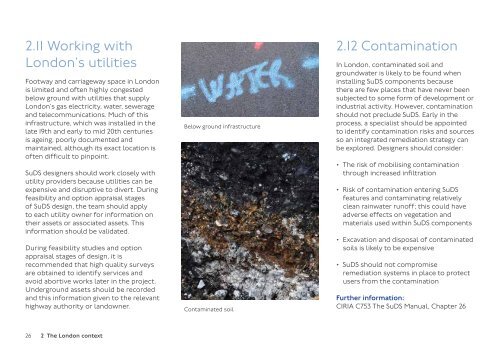SuDS in London - a guide
sustainable-urban-drainage-november-2016
sustainable-urban-drainage-november-2016
Create successful ePaper yourself
Turn your PDF publications into a flip-book with our unique Google optimized e-Paper software.
2.11 Work<strong>in</strong>g with<br />
<strong>London</strong>’s utilities<br />
Footway and carriageway space <strong>in</strong> <strong>London</strong><br />
is limited and often highly congested<br />
below ground with utilities that supply<br />
<strong>London</strong>’s gas electricity, water, sewerage<br />
and telecommunications. Much of this<br />
<strong>in</strong>frastructure, which was <strong>in</strong>stalled <strong>in</strong> the<br />
late 19th and early to mid 20th centuries<br />
is age<strong>in</strong>g, poorly documented and<br />
ma<strong>in</strong>ta<strong>in</strong>ed, although its exact location is<br />
often difficult to p<strong>in</strong>po<strong>in</strong>t.<br />
<strong>SuDS</strong> designers should work closely with<br />
utility providers because utilities can be<br />
expensive and disruptive to divert. Dur<strong>in</strong>g<br />
feasibility and option appraisal stages<br />
of <strong>SuDS</strong> design, the team should apply<br />
to each utility owner for <strong>in</strong>formation on<br />
their assets or associated assets. This<br />
<strong>in</strong>formation should be validated.<br />
Dur<strong>in</strong>g feasibility studies and option<br />
appraisal stages of design, it is<br />
recommended that high quality surveys<br />
are obta<strong>in</strong>ed to identify services and<br />
avoid abortive works later <strong>in</strong> the project.<br />
Underground assets should be recorded<br />
and this <strong>in</strong>formation given to the relevant<br />
highway authority or landowner.<br />
Below ground <strong>in</strong>frastructure<br />
Contam<strong>in</strong>ated soil<br />
2.12 Contam<strong>in</strong>ation<br />
In <strong>London</strong>, contam<strong>in</strong>ated soil and<br />
groundwater is likely to be found when<br />
<strong>in</strong>stall<strong>in</strong>g <strong>SuDS</strong> components because<br />
there are few places that have never been<br />
subjected to some form of development or<br />
<strong>in</strong>dustrial activity. However, contam<strong>in</strong>ation<br />
should not preclude <strong>SuDS</strong>. Early <strong>in</strong> the<br />
process, a specialist should be appo<strong>in</strong>ted<br />
to identify contam<strong>in</strong>ation risks and sources<br />
so an <strong>in</strong>tegrated remediation strategy can<br />
be explored. Designers should consider:<br />
• The risk of mobilis<strong>in</strong>g contam<strong>in</strong>ation<br />
through <strong>in</strong>creased <strong>in</strong>filtration<br />
• Risk of contam<strong>in</strong>ation enter<strong>in</strong>g <strong>SuDS</strong><br />
features and contam<strong>in</strong>at<strong>in</strong>g relatively<br />
clean ra<strong>in</strong>water runoff; this could have<br />
adverse effects on vegetation and<br />
materials used with<strong>in</strong> <strong>SuDS</strong> components<br />
• Excavation and disposal of contam<strong>in</strong>ated<br />
soils is likely to be expensive<br />
• <strong>SuDS</strong> should not compromise<br />
remediation systems <strong>in</strong> place to protect<br />
users from the contam<strong>in</strong>ation<br />
Further <strong>in</strong>formation:<br />
CIRIA C753 The <strong>SuDS</strong> Manual, Chapter 26<br />
26 2 The <strong>London</strong> context


